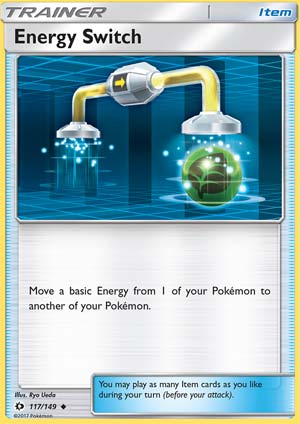
21times |
Energy Switch
(Sun & Moon, 117/149) allows you to move one
basic energy from one of your Pokemon to another.
No tricks, no gimmicks, it comes completely as
advertised.
Got an extra energy on your active and you want save
that because he’s about to get KO’d?
Done.
Just hit a Max Elixir (Breakpoint, 102/122) and need to get that energy
on to your active?
No problem.
It has a variety of uses and can give your attack
a huge boost.
Personally, I ran a couple in a
Xerneas (Breakthrough,
107/162) Rainbow Road deck that I used to run and had
quite a bit of success with.
I can’t tell you how many times I’d drop a DCE
down on my active
Xerneas, hit an
Elixir, and
then play Energy
Switch.
It worked as a great combo many times.
However, I haven’t seen much reason to run it
since. It
probably could see more play in decks like
Volcanion (Steam
Siege, 25/114),
Yveltal (Steam
Siege, 65/114), or
Xerneas (XY,
96/146), and maybe we too often overlook it.
I could do an analysis on this fairly easily,
track wins and losses in a deck with and then without
Energy Switch,
but my current project – tracking the amount of damage
each attack does to an active Pokemon – certainly has
more value.
Rating
Standard: 2 out of 5
Summary
While not a completely
worthless card, a sixty card deck simply doesn’t have
enough room in it for
Energy Switch. Look at
it this way: no deck finishing in the top eight of the
masters division in any tournament since the new
rotation WAY back in September has run even a single
copy of Energy
Switch.
|
|
|
This Throwback
Thursday we look at Energy Switch… which may not
seem like much of a throwback since it was just
re-released, but its release history is Aquapolis
120/147 (January 15, 2003), EX: Ruby & Sapphire
82/109 (June 18, 2003), EX: FireRed/LeafGreen
(August 30, 2004), EX: Unseen Forces 84/115
(August 2, 2005), EX: Power Keepers 75/108
(February 14, 2007), Diamond & Pearl 107/130 (May
23, 2007), DP: Stormfront 84/100 (November 5,
2008), HeartGold & SoulSilver 91/123 (February
10, 2010), Black & White 94/114 (April 25, 2011),
BW: Legendary Treasures 112/113 (November 8,
2013), XY: Furious Fists 89/111 (August 13,
2014), XY: Roaring Skies 109/108(May 6, 2015),
Generations 61/83 (February 22, 2016), and Sun &
Moon 117/149 (February 1, 2017). Fourteen years
of Energy Switch and… I barely saw it used until
about four years ago. As we are re-reviewing a
well-known card, I don’t believe it problematic to give
a general opinion of it before getting more detailed; it
is possible players (or just myself) didn’t recognize
its value back in the day, but reading
the
past
CotD
reviews you can see that only a few
reviewers thought it worth the effort… until what was
the last review (and is now the next-to-last).
Energy Switch
is a Trainer and Item card, even the oldest versions
count as such since that is the rule for Trainer cards
that weren’t a Stadium or Supporter and released prior
to Black & White. There isn’t a huge amount
of cards in the modern game that specifically affect
Trainers (as opposed to Items), but Dowsing Machine,
Skyla and Trainers’ Mail are worth naming,
while the few anti-Trainer effects still legal are
thankfully only worth mentioning in general, to
acknowledge their existence. Being an Item is much
more relevant, but not in a good way. In the
Legacy Format you’ve got Junk Arm to recycle it,
and some less general tricks in Expanded and Standard
play, including Sableye (BW: Dark Explorers
62/108) and its “Junk Hunt” attack, but the main thing
is Item lock remains a popular and potent strategy in
both Standard and Expanded play. Other than the
frequency of Item lock, there is no drawback to an
Item’s use; beyond the universal cost applicable to all
cards, an Item only adds whatever is specific to its
text. In this case, you’ll need at least two
Pokémon and a basic Energy card in play, so that
Energy Switch can move said Energy from one Pokémon
to another.
Energy acceleration
is a funny thing; there are four major types of it:
Energy acceleration from the deck, the discard, the
field, and the hand. It is something of a toss-up
as to whether from the deck or the discard pile is
better, but from the field is usually the worst.
That is because it isn’t actually increasing the amount
of Energy you have in play, but rather moving it around
to your benefit. Except actually benefiting from
this can be tricky. With a card like Energy
Switch, the first thing that sprang to my mind all
those years ago was to save a basic Energy card from
being discarded because the Pokémon to which it was
initially attached was going to be KO’d. Unless
that Pokémon has a worthwhile attack it may use without
that Energy, was just up front to stall, etc. you’ll
need to be able to Bench it and start attacking with
something new (probably the Pokémon that received an
Energy via Energy Switch), or else you lose
momentum. Ending up one basic Energy ahead for the
cost of an Item is good but if you can’t keep up
the pressure, you’re also sacrificing an attack.
At the time, I also Energy Switch thought of
using Energy Switch to assist decks that ran
multiple Energy Types since that increased your odds of
having attached something to a less-than-optimal target.
It would also flat out help correct a misplay, but that
isn’t usually a good selling point for a card, and
neither is helping out most multi-Type decks; it is just
easier to run a Special Energy which counts as multiple
Types or more basic Energy search/recycling
effects. Even if you had an effect that attached
Energy but only to a specific target, at that
time it wasn’t usually worth an Item to move it.
To be clear, sometimes this was in part because there
were better solutions; Pokémon-based effects to move
Energy (sometimes over and over again, even in the same
turn) or when the attachment was restricted to something
like a Benched Pokémon, just using a Switch to
Bench your current Active while bringing up something
with a free Retreat Cost.
So what changed?
Primarily it was pacing, but there are a few other bits
as well. The game became faster, and Item cards
were effectively less “costly” to play. Basics
were able to hit harder for less Energy, so the one
basic Energy moved by a single Energy Switch
began to matter more. Basic Energy cards seem to
have more and better support than before, while the
focus of Special Energy cards seems to be changing;
Double Colorless Energy and Rainbow Energy
work in many, many decks but everything else in
Standard works for Pokémon of a specific Type or
name-based association. Expanded has a few more,
they are variations on Rainbow Energy (Blend
Energy GRPD, Blend Energy WLFM, Plasma
Energy, and Prism Energy). Compare and
contrast that to having cards like Boost Energy,
Double Rainbow Energy, Scramble Energy,
and Warp Energy; all the conditions were there,
but jumbled about, with Pokémon-Type-specific
stuff being the domain of just Darkness and Metal
Pokémon. More combos for Energy Switch
popped up, like using AZ or Max Potion on
a single-Energy attacker after its original
Energy was moved to another attacker. More
conditional Energy acceleration was added. Put it
all together, and suddenly Darkrai-EX (BW:
Dark Explorers 63/108, 107/108; BW: Black Star
Promos BW46; BW: Legendary Treasures 88/113)
and Dark Patch, backed by Sableye and its
Junk Hunt, are pulling off power combos.
Energy Switch
is not for every deck; anything with basic Energy
could technically use it, but if you’re not feeding into
a combo, it just isn’t worth it. Even in decks
that can make good use of it, you have to consider how
likely you are to face Item lock (or face it without
having a counter). I believe this really
hurts Energy Switch in Standard and Expanded
play, though it is pretty good in the Legacy Format
(where Junk Arm can recycle it in most decks).
In Limited play, this is a useful card, unless you’re
able to build a strong deck around a single Pokémon (as
sometimes happens). So why look at it now?
Besides being a card from the newest set but is
still old enough to qualify for Throwback Thursday,
there is a card we are likely to receive soon called
Multi Switch. If translations are correct (of
course it has already released in Japan), this is just
an Energy Switch that can be used with Special
Energy (still works on basic Energy as well).
If this holds true, soon Energy Switch will be
obsolete unless a deck somehow needs more than four
copies of it.
Ratings
Standard:
2/5
Expanded:
2/5
Limited:
3.75/5
Legacy:
3/5
Conclusion
This does not
seem to be a good time for Energy Switch, but it
isn’t the worst time for it. It took about a
decade before the metagame was ripe for it, and has
enjoyed the years since then, but crowded decks and Item
lock are really taking their toll. Expanded offers
more opportunities but more counters and competition
than Standard, so I’m taking the simple approach of
scoring them the same. The scores arecomposite;
Energy Switch is still a great play in certain
decks, but ones where it is essential, I don’t recall
still being worth the effort. So those are diluted
by the ones where it is okay or even a poor fit, and
that is brought lower because Item lock applies across
the board. Finally, Multi Switch means
Energy Switch will soon be unneeded.
|




